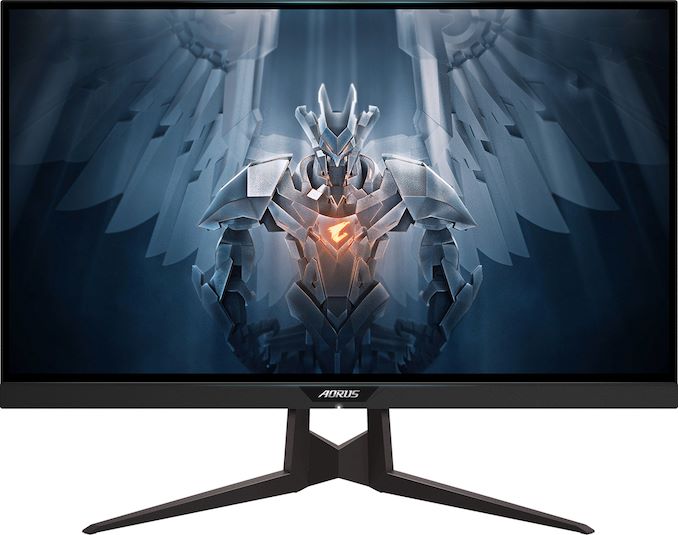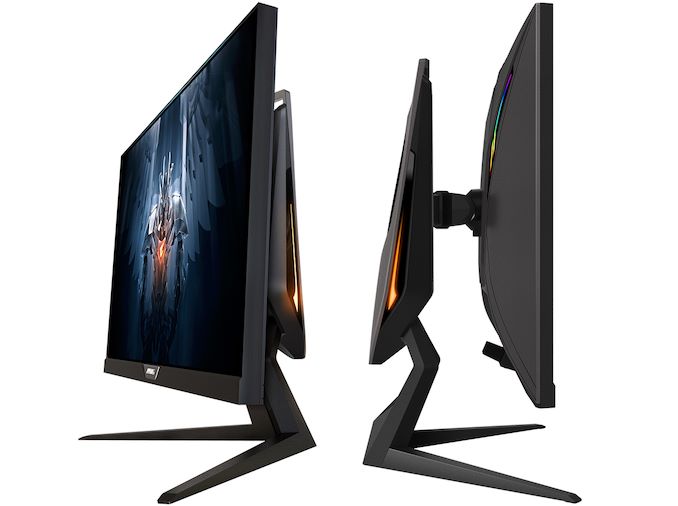More Hz for Less: GIGABYTE Unveils Aorus FI27Q 27-Inch 165 Hz Monitor
by Anton Shilov on January 31, 2020 3:00 PM EST
GIGABYTE has introduced its 2nd Generation 27-inch ‘tactical’ display for gamers, updating the display to offer a maximum refresh rate of 165 Hz. The Aorus FI27Q monitor continues to use a high-quality IPS panel and supports a variety of premium features, including VESA adaptive-sync and noise cancellation. Meanwhile, the new LCD is $50 cheaper than its predecessor from last year. Meanwhile, GIGABYTE also announced the Aorus FI27Q-P monitor that has a DisplayPort 1.4 input and some other feature set improvements.
The GIGABYTE Aorus FI27Q is based on a 2560×1440 resolution 8-bit+FRC IPS panel, which offers 350 nits max luminance, a 1000:1 contrast ratio, 178/178 viewing angles, a 1 ms MPRT response time, and a maximum refresh rate of 165 Hz. As you'd expect from such a high refresh rate monitor, the display supports VESA's adaptive-sync variable refresh technology, and is both AMD FreeSync Premium and NVIDIA G-Sync Compatible certified. The LCD also supports GIGABYTE’s Aim Stabilizer technology that reduces motion blur and promises to make fast-paced scenes look sharper, though it is unclear whether it works with variable refresh rates.
Courtesy to its high-quality panel, the Aorus FI27Q monitor can display 95% of the DCI-P3 color gamut and supports HDR mode (presumably using HDR10 transport, but GIGABYTE has not formally confirmed this). Though don't expect the latter to provide a really good HDR experience, given the mediocre brightness.
Being one of the leading makers of computer components, GIGABYTE offers a wide range of products aimed at virtually all segments of the market. But a notable exception to this has been displays, where the company is focusing on the high-end segment and loading its monitors up with extra features. Among other features on the FI27Q is active noise cancellation (ANC) technology for any headset connected to the display, OSD Sidekick to control display options using a keyboard and a mouse, Dashboard to display hardware-related information on top, custom crosshairs, and game profiles.
As far as connectivity is concerned, the Aorus FI27Q display has a DisplayPort 1.2 input, two HDMI 2.0 ports, and audio connectors. Ergonomics-wise, the monitor comes with a stand designed after a falcon and featuring multiple addressable RGB LEDs that can adjust the display’s height, tilt, and swivel. In addition, the LCD has VESA 100mm×100mm mounting holes.
It is noteworthy that GIGABYTE is also offering the Aorus FI27Q-P monitor with a DisplayPort 1.4, which essentially means that the monitor can support a 10-bit input at the monitor's full resolution and 165 Hz refresh rate. By contrast, the Aorus FI27Q only supports an 8-bit input for this scenario due to DP 1.2 bandwidth limitations. In addition, the -P version also comes with ANC 2.0 and Black Equalizer 2.0.
| The GIGABYTE Aorus FI27Q Monitors | |||
| Aorus FI27Q | Aorus FI27Q-P | ||
| Panel | 27" 8-bit + FRC IPS | ||
| Native Resolution | 2560 × 1440 (16:9) |
||
| Refresh Rate | 165 Hz | ||
| Dynamic Refresh Rate | Technology | VESA Adaptive-Sync (AMD FreeSync Premium & NVIDIA G-Sync Compatible Certified) |
|
| Range | 48 - 165Hz | ||
| Response Time | 1 ms MPRT | ||
| Brightness | 350 cd/m² | ||
| Contrast | 1000:1 | ||
| Color Gamut | 95% DCI-P3 | ||
| Viewing Angles | 178°/178° horizontal/vertical | ||
| Curvature | - | ||
| Inputs | 1 × DisplayPort 1.2 2 × HDMI 2.0 |
1 × DisplayPort 1.4 2 × HDMI 2.0 |
|
| USB Hub | - | ||
| Audio | audio connectors | ||
| Proprietary Enhancements | Active Noise Cancellation Aim Stabilizer Black Stabilizer Game Assist custom crosshairs Aorus Dashboard OSD Sidekick Game Profiles |
Active Noise Cancellation 2.0 Aim Stabilizer Black Stabilizer 2.0 Game Assist custom crosshairs Aorus Dashboard OSD Sidekick Game Profiles |
|
| Stand | Height | 130 mm | |
| Tilt | +21° ~ -5° | ||
| Swivel | +20° ~ -20° | ||
| Power Consumption | Idle | 0.5 W | |
| Typical | ? | ||
| Maximum | 75 W | ||
| MSRP | $549 | ? | |
The GIGABYTE Aorus FI27Q (and perhaps FI27Q-P) display is now available from retailers like Amazon and Newegg for $549, which is $50 lower compared to the launch price of the Aorus AD27QD.
Related Reading:
- GIGABYTE’s Aorus CV27Q Curved ‘Tactical’ Monitor: 165 Hz QHD With FreeSync 2
- CES 2019: A Monitor from GIGABYTE? The 1440p 144 Hz IPS FreeSync 'Aorus AD27QD'
- AOC Launches CQ27G1 Curved Monitor: 27 Inch, 144 Hz, FreeSync, Sub-$300
- Samsung’s CRG5 Curved 27-Inch 240 Hz G-Sync Monitor Now Available for $370
- Dell Rolls Out 32-Inch QHD Curved Gaming Monitor (S3220DGF): Up To 165Hz with FreeSync 2
- LG Unveils 27 and 37.5-Inch IPS Monitors with 1 ms Response Time
Source: GIGABYTE












25 Comments
View All Comments
Beaver M. - Sunday, February 2, 2020 - link
LCD still will always have motion blur. It will never be as the motions on CRTs, even if you slap 1000Hz on one. And even CRTs were not completely without motion blur.p1esk - Monday, February 3, 2020 - link
Again, I'm not talking about LCDs. I believe we will see first proper MicroLED monitors at the next CES, or maybe the one after, but not later than that. After that it will probably take a couple of years to see them on the shelves, and a couple more years later it just won't make any sense to produce monitors with any other technology (unless something even better is invented by then).mode_13h - Tuesday, February 4, 2020 - link
CRT phosphors had an exponential decay function. So, you could absolutely get motion blur-like artifacts on them.Also, I don't recall seeing refresh rates much above 120 Hz, on CRT monitors. And you'd have to drop the resolution to hit that.
mode_13h - Saturday, February 1, 2020 - link
They're not orthogonal, in part because of DisplayPort 1.2 bandwidth limitations. That's why the FI27Q-P is the real news, since its DisplayPort 1.4 lets you have HDR @ 165 Hz.mode_13h - Saturday, February 1, 2020 - link
> It is noteworthy that GIGABYTE is also offering the Aorus FI27Q-P monitor with a DisplayPort 1.4Exactly. This article is several months late. Now, you should be focusing on the -P variant!